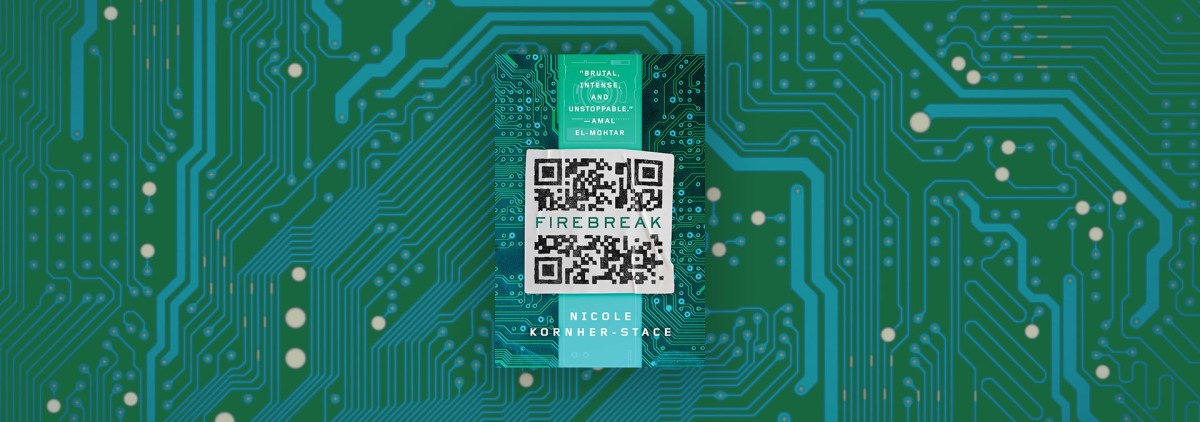[ad_1]
Science fiction dystopias have often featured authoritarian governments, yet increasingly in the real world, the nation-state is ceding power to privately held corporations. Hypercapitalism threatens individual liberty in Nicole Kornher-Stace’s Firebreak, where two megacorporations have all but replaced the American government and control essential natural resources.
Mal and her best friend Jessa live in the slums outside New Liberty City, a super megapolis constructed to accommodate climate refugees, but ruled by two warring corporations. From their overcrowded living space, they hold odd jobs, endure nightly power curfews, and stream themselves playing an online game. The virtual game world replicates the real world they live in, with accurate details of New Liberty City recreated in the game. It is seemingly the main form of entertainment for average citizens who buy collectibles and pay subscriptions to several different streams. The in-game plot mirrors the real-world conflict, with skirmishes between players and the Non-Player Characters reflecting the real-world battles between corporations. Mal and Jessica’s stream supplements their meager income, with subscribers paying tips of in-game power ups and in-real-life water allocations.
Water is controlled by Stellaxis Innovations, one of two corporations ruling over the city, while the adversarial Greenleaf controls agriculture. These two megacorporations control not just resources, but justice and rule of law. A forever war fueled by tensions between Greenleaf and Stellaxis threatens the stability of civilian life, but also provides the storyline for the online game Mal and Jessa play.
Stellaxis controls access to the game but also sells action figures and collectibles, allowing the game to transcend the digital realm while also generating another revenue stream. For players, the main focus of the game is climbing the leaderboards. The top-ranked player is granted access to Non-Player Characters who can help battle other players or complete in-game quests. The twist though is these NPCs are modeled on real-world people, heroes Stellaxis created to battle the Greenleaf mechs ravaging the city. Legend has it Stellaxis grew these heroes in their advanced science labs, providing them superhuman strengths augmented by Stellaxis war technology.
Mal and Jessa spend most of their time attempting to record footage of the NPC characters, known by non-sequential numbers. Although the in-game NPCs are built on artificial intelligence, the game recreates the personalities of their real-world counterparts. Eventually, Mal’s efforts pique the interest of a sponsor, who offers the duo a weekly water allowance. The sponsor convinces Mal that the original heroes were actually children abducted by Stellaxis and sets Mal on a real-world quest to uncover the conspiracy.
The game-world and real-world environments begin to blend together as Mal delves deeper into the conspiracy. She even observes at one point, “it’s like I’m in the game.” This blurring of the game and waking world extends further with Mal eventually looting dead bodies just as she would in the game. The effect creates a surreal narrative environment where the real and virtual blend.
A continuous stream of mysteries drives the action of the novel. Just as Mal learns a critical piece of knowledge, another question arises. Adding to this sense of forward motion, the novel’s environment and characters’ objectives continually evolve as well. At first, we’re immersed in the video game world as Mal, known as her alter ego Nycorix, frags enemies. But the novel quickly becomes a conspiracy-driven mystery, then a fast-paced battle sequence, and eventually a revenge plot, roughly corresponding with the novel’s four parts. Each of these sections largely takes place in a distinct environment. The in-game world dominates the first section, but the locations later recenter around New Liberty City, Old Town, and the Stellaxis headquarters. These shifting environments also help make the novel feel as though the plot is continually moving forward.
The true villain in the novel is not an individual or even the evil corporation, but capitalism itself. The two corporations exist as virtual monopolies unchecked by laws or government, and they create a harsh world for people to live in. Although water seems scarce for Mal and residents of Old Town, at the corporate headquarters, it flows freely. Mal recognizes that there are not any actual shortages, only artificial limits created by the corporation to drive profits. Even the villainous Director of the Stellaxis science team paints herself as a victim of the system. Her confession ultimately points to a faceless corporation refusing her requests to terminate the evil program she oversaw. Although she is deflecting blame away from herself towards an anonymous corporate entity, her efforts further indict capitalism.
At the center of the novel is a deep friendship between Mal and Jessa. In the dystopian world ruled by hypercapitalism, the human connection between two people proves a powerful force. Their friendship motivates the characters, and like all close friendships is often strained by their competing personalities. But those differences make them stronger. Moreover, their friendship contrasts the market capitalism they struggle against. They succeed when they cooperate with each other. When the pair receive a bounty of water from their sponsor, they share the wealth. When the water in Old Town is turned off, Jessa and Mal pool the water they have reserved for the collective good. Friendship and human commune are the antithesis of the capitalism dominating their world.
Corporations are on trial in this novel. If 1984 and Brave New World were warnings against authoritarian governments, Firebreak is a warning against unchecked capitalism. By combining familiar science fiction elements with a strong critique of the commodification of essential elements of life and the corrupting influence of power, Firebreak offers a frightening warning against a near-future dominated by the rule of megacorporations.

FICTION
Firebreak
By Nicole Kornher-Stace
Gallery/Saga Press
Published May 4, 2021
[ad_2]
Source link
